A Comparative Study of Stem Rot Severity in Mature Deciduous Trees in Latvia
Abstract
1. Introduction
- What variations exist in stem rot severity among different mature deciduous species?
- How does the severity of individual stem rot change in relation to tree characteristics within a stand?
- In which species might the impact of rot on aboveground biomass be most significant?
2. Materials and Methods
2.1. Study Area
2.2. Data Collection
- Discolored wood: includes wood that has experienced discoloration but retains most of its mechanical properties, with only minor changes.
- Decomposed wood: comprises wood that has undergone decomposition to the extent that it can be squeezed between two fingers, indicating a significant loss of structural integrity.
- Hollow: refers to wood with a hollow interior, signifying substantial decay and the presence of a void or empty space within the tree stem.
2.3. Data Analysis
3. Results
3.1. Stem Rot Incidence in Mature Stands
3.2. Stem Rot Severity and Variability across Tree Species
3.3. Effect of Tree Characteristics on Rot Amount
3.4. Effect of Stump Characteristics on Rot Amount
4. Discussion
4.1. Stem Rot Incidence and Variability across Tree Species
4.2. Challenges Faced in Predicting Stem Rot Severity
4.3. Importance of Stem Rot in Tree Biomass Estimations
5. Conclusions
Author Contributions
Funding
Institutional Review Board Statement
Informed Consent Statement
Data Availability Statement
Acknowledgments
Conflicts of Interest
References
- Lier, M.; Köhl, M.; Korhonen, K.T.; Linser, S.; Prins, K.; Talarczyk, A. The New EU Forest Strategy for 2030: A New Understanding of Sustainable Forest Management? Forests 2022, 13, 245. [Google Scholar] [CrossRef]
- Bauhus, J.; Puettmann, K.; Messier, C. Silviculture for Old-Growth Attributes. For. Ecol. Manag. 2009, 258, 525–537. [Google Scholar] [CrossRef]
- DellaSala, D.A.; Mackey, B.; Norman, P.; Campbell, C.; Comer, P.J.; Kormos, C.F.; Keith, H.; Rogers, B. Mature and Old-Growth Forests Contribute to Large-Scale Conservation Targets in the Conterminous United States. Front. For. Glob. Chang. 2022, 5, 979528. [Google Scholar] [CrossRef]
- Luyssaert, S.; Schulze, E.-D.; Börner, A.; Knohl, A.; Hessenmöller, D.; Law, B.E.; Ciais, P.; Grace, J. Old-Growth Forests as Global Carbon Sinks. Nature 2008, 455, 213–215. [Google Scholar] [CrossRef] [PubMed]
- Gundersen, P.; Thybring, E.E.; Nord-Larsen, T.; Vesterdal, L.; Nadelhoffer, K.J.; Johannsen, V.K. Old-Growth Forest Carbon Sinks Overestimated. Nature 2021, 591, E21–E23. [Google Scholar] [CrossRef] [PubMed]
- Luyssaert, S.; Schulze, E.-D.; Knohl, A.; Law, B.E.; Ciais, P.; Grace, J. Reply to: Old-Growth Forest Carbon Sinks Overestimated. Nature 2021, 591, E24–E25. [Google Scholar] [CrossRef] [PubMed]
- Yang, H.; Ciais, P.; Frappart, F.; Li, X.; Brandt, M.; Fensholt, R.; Fan, L.; Saatchi, S.; Besnard, S.; Deng, Z.; et al. Global Increase in Biomass Carbon Stock Dominated by Growth of Northern Young Forests over Past Decade. Nat. Geosci. 2023, 16, 886–892. [Google Scholar] [CrossRef]
- Vilén, T.; Gunia, K.; Verkerk, P.J.; Seidl, R.; Schelhaas, M.-J.; Lindner, M.; Bellassen, V. Reconstructed Forest Age Structure in Europe 1950–2010. For. Ecol. Manag. 2012, 286, 203–218. [Google Scholar] [CrossRef]
- Seifert, T. Simulating the Extent of Decay Caused by Heterobasidion annosum s. l. in Stems of Norway Spruce. For. Ecol. Manag. 2007, 248, 95–106. [Google Scholar] [CrossRef]
- Shigo, A.L.; Hillis, W.E. Heartwood, Discolored Wood, and Microorganisms in Living Trees. Annu. Rev. Phytopathol. 1973, 11, 197–222. [Google Scholar] [CrossRef]
- Frank, J.; Castle, M.E.; Westfall, J.A.; Weiskittel, A.R.; Macfarlane, D.W.; Baral, S.K.; Radtke, P.J.; Pelletier, G. Variation in Occurrence and Extent of Internal Stem Decay in Standing Trees across the Eastern US and Canada: Evaluation of Alternative Modelling Approaches and Influential Factors. Forestry 2018, 91, 382–399. [Google Scholar] [CrossRef]
- Orozco-Aguilar, L.; Johnstone, D.; Livesley, S.J.; Brack, C. The Overlooked Carbon Loss Due to Decayed Wood in Urban Trees. Urban For. Urban Green. 2018, 29, 142–153. [Google Scholar] [CrossRef]
- Barba, J.; Bradford, M.A.; Brewer, P.E.; Bruhn, D.; Covey, K.; van Haren, J.; Megonigal, J.P.; Mikkelsen, T.N.; Pangala, S.R.; Pihlatie, M.; et al. Methane Emissions from Tree Stems: A New Frontier in the Global Carbon Cycle. New Phytol. 2019, 222, 18–28. [Google Scholar] [CrossRef] [PubMed]
- Heineman, K.D.; Russo, S.E.; Baillie, I.C.; Mamit, J.D.; Chai, P.P.K.; Chai, L.; Hindley, E.W.; Lau, B.T.; Tan, S.; Ashton, P.S. Evaluation of Stem Rot in 339 Bornean Tree Species: Implications of Size, Taxonomy, and Soil-Related Variation for Aboveground Biomass Estimates. Biogeosciences 2015, 12, 5735–5751. [Google Scholar] [CrossRef]
- Schneider, R.; Riopel, M.; Pothier, D.; Côté, L. Predicting Decay and Round-Wood End Use Volume in Trembling Aspen (Populus tremuloides Michx.). Ann. For. Sci. 2008, 65, 608. [Google Scholar] [CrossRef]
- Hallaksela, A.M.; Niemistö, P. Stem Discoloration of Planted Silver Birch. Scand. J. For. Res. 1998, 13, 169–176. [Google Scholar] [CrossRef]
- Liepiņš, J.; Jaunslaviete, I.; Liepiņš, K.; Jansone, L. Effect of Stem Rot on Wood Basic Density, Carbon, and Nitrogen Content of Living Deciduous Trees in Hemiboreal Forests. Silva Fenn. 2023, 57, 23040. [Google Scholar] [CrossRef]
- Rytter, L.; Johansson, K.; Karlsson, B.; Stener, L.G. Tree Species, Genetics and Regeneration for Bioenergy Feedstock in Northern Europe. In Forest BioEnergy Production: Management, Carbon Sequestration and Adaptation; Springer: New York, NY, USA, 2013; pp. 7–37. ISBN 9781461483915. [Google Scholar]
- Hermoso, V.; Carvalho, S.B.; Giakoumi, S.; Goldsborough, D.; Katsanevakis, S.; Leontiou, S.; Markantonatou, V.; Rumes, B.; Vogiatzakis, I.N.; Yates, K.L. The EU Biodiversity Strategy for 2030: Opportunities and Challenges on the Path towards Biodiversity Recovery. Environ. Sci. Policy 2022, 127, 263–271. [Google Scholar] [CrossRef]
- Hoover, C.M.; Smith, J.E. Aboveground Live Tree Carbon Stock and Change in Forests of Conterminous United States: Influence of Stand Age. Carbon Balance Manag. 2023, 18, 7. [Google Scholar] [CrossRef]
- Fraser, J.S.; Pile Knapp, L.S.; Graham, B.; Jenkins, M.A.; Kabrick, J.; Saunders, M.; Spetich, M.; Shifley, S. Carbon Dynamics in Old-Growth Forests of the Central Hardwoods Region, USA. For. Ecol. Manag. 2023, 537, 120958. [Google Scholar] [CrossRef]
- Ķēniņa, L.; Elferts, D.; Jaunslaviete, I.; Bāders, E.; Šņepsts, G.; Jansons, Ā. Tree Biomass—A Fragile Carbon Storage in Old-Growth Birch and Aspen Stands in Hemiboreal Latvia. Balt. For. 2022, 28, 654. [Google Scholar] [CrossRef]
- Matsuzaki, E.; Sanborn, P.; Fredeen, A.L.; Shaw, C.H.; Hawkins, C. Carbon Stocks in Managed and Unmanaged Old-Growth Western Redcedar and Western Hemlock Stands of Canada’s Inland Temperate Rainforests. For. Ecol. Manag. 2013, 297, 108–119. [Google Scholar] [CrossRef]
- Marra, R.E.; Brazee, N.J.; Fraver, S. Estimating Carbon Loss Due to Internal Decay in Living Trees Using Tomography: Implications for Forest Carbon Budgets. Environ. Res. Lett. 2018, 13, 105004. [Google Scholar] [CrossRef]
- Hauck, M.; Csapek, G.; Dulamsuren, C. The Significance of Large Old Trees and Tree Cavities for Forest Carbon Estimates. For. Ecol. Manag. 2023, 546, 121319. [Google Scholar] [CrossRef]
- Martin, A.R.; Domke, G.M.; Doraisami, M.; Thomas, S.C. Carbon Fractions in the World’s Dead Wood. Nat. Commun. 2021, 12, 889. [Google Scholar] [CrossRef] [PubMed]
- Köster, K.; Metslaid, M.; Engelhart, J.; Köster, E. Dead Wood Basic Density, and the Concentration of Carbon and Nitrogen for Main Tree Species in Managed Hemiboreal Forests. For. Ecol. Manag. 2015, 354, 35–42. [Google Scholar] [CrossRef]
- Šenhofa, S.; Jaunslaviete, I.; Šņepsts, G.; Jansons, J.; Liepa, L.; Jansons, A. Deadwood Characteristics in Mature and Old-Growth Birch Stands and Their Implications for Carbon Storage. Forests 2020, 11, 536. [Google Scholar] [CrossRef]
- Stakėnas, V.; Varnagirytė-Kabašinskienė, I.; Sirgedaitė-Šėžienė, V.; Armolaitis, K.; Araminienė, V.; Muraškienė, M.; Žemaitis, P. Dead Wood Carbon Density for the Main Tree Species in the Lithuanian Hemiboreal Forest. Eur. J. For. Res. 2020, 139, 1045–1055. [Google Scholar] [CrossRef]
- Zabel, R.A.; Morrell, J.J. Decays Originating in the Stems of Living Trees. In Wood Microbiology; Academic Press: San Diego, CA, USA, 2020; pp. 311–337. [Google Scholar] [CrossRef]
- Soge, A.O.; Popoola, O.I.; Adetoyinbo, A.A. Detection of Wood Decay and Cavities in Living Trees: A Review. Can. J. For. Res. 2021, 51, 937–947. [Google Scholar] [CrossRef]
- Ahti, T.; Hämet-Ahti, L.; Jalas, J. Vegetation Zones and Their Sections in Northwestern Europe. Ann. Bot. Fenn. 1968, 3, 169–211. [Google Scholar]
- Allikmäe, E.; Laarmann, D.; Korjus, H. Vitality Assessment of Visually Healthy Trees in Estonia. Forests 2017, 8, 223. [Google Scholar] [CrossRef]
- Liepa, I. Pieauguma Mācība; LLU: Jelgava, Latvia, 1996. [Google Scholar]
- Lundgren, L.N.; Pan, H.; Theander, O.; Eriksson, H.; Johansson, U.; Svenningsson, M. Development of a New Chemical Method for Distinguishing between Betulapendula and Betulapubescens in Sweden. Can. J. For. Res. 1995, 25, 1097–1102. [Google Scholar] [CrossRef]
- R Core Team. R: A Language and Environment for Statistical Computing; R Foundation for Statistical Computing: Vienna, Austria, 2022. [Google Scholar]
- Bates, D.; Mächler, M.; Bolker, B.; Walker, S. Fitting Linear Mixed-Effects Models Using Lme4. J. Stat. Softw. 2015, 67, 51. [Google Scholar] [CrossRef]
- Arnqvist, G. Mixed Models Offer No Freedom from Degrees of Freedom. Trends Ecol. Evol. 2020, 35, 329–335. [Google Scholar] [CrossRef] [PubMed]
- Fox, J.; Weisberg, S. An R Companion to Applied Regression, 3rd ed.; Sage: Thousand Oaks, CA, USA, 2019. [Google Scholar]
- Bartoń, K. MuMIn: Multi-Model Inference. R Package Version 1.46.0. Available online: https://cran.r-project.org/package=MuMIn (accessed on 20 December 2023).
- Johansson, T. Discolored Stems of 12-63-Year-Old European Aspen (Populus tremula L.); Department of Energy and Technology, Swedish University of Agricultural Sciences: Uppsala, Swedish, 2013. [Google Scholar]
- Arhipova, N.; Gaitnieks, T.; Donis, J.; Stenlid, J.; Vasaitis, R. Decay, Yield Loss and Associated Fungi in Stands of Grey Alder (Alnus incana) in Latvia. Forestry 2011, 84, 337–348. [Google Scholar] [CrossRef]
- Kärki, T.; Maltamo, M.; Eerikäinen, K. Diameter Distribution, Stem Volume and Stem Quality Models for Grey Alder (Alnus incana) in Eastern Finland. New For. 2000, 20, 65–86. [Google Scholar] [CrossRef]
- Arhipova, N.; Gaitnieks, T.; Donis, J.; Stenlid, J.; Vasaitis, R. Heart-Rot and Associated Fungi in Alnus Glutinosa Stands in Latvia. Scand. J. For. Res. 2012, 27, 327–336. [Google Scholar] [CrossRef]
- Claessens, H.; Oosterbaan, A.; Savill, P.; Rondeux, J. A Review of the Characteristics of Black Alder (Alnus glutinosa (L.) Gaertn.) and Their Implications for Silvicultural Practices. Forestry 2010, 83, 163–175. [Google Scholar] [CrossRef]
- Uri, V.; Kukumägi, M.; Aosaar, J.; Varik, M.; Becker, H.; Soosaar, K.; Morozov, G.; Ligi, K.; Padari, A.; Ostonen, I.; et al. Carbon Budgets in Fertile Grey Alder (Alnus incana (L.) Moench.) Stands of Different Ages. For. Ecol. Manag. 2017, 396, 55–67. [Google Scholar] [CrossRef]
- Hynynen, J.; Niemistö, P.; Viherä-Aarnio, A.; Brunner, A.; Hein, S.; Velling, P. Silviculture of Birch (Betula pendula Roth and Betula pubescens Ehrh.) in Northern Europe. For. Int. J. For. Res. 2010, 83, 103–119. [Google Scholar] [CrossRef]
- Stener, L.G.; Rytter, L.; Jansson, G. Effects of Pruning on Wood Properties of Planted Silver Birch in Southern Sweden. Silva Fenn. 2017, 51, 1713. [Google Scholar] [CrossRef][Green Version]
- Buht, M.; Padari, A.; Aosaar, J.; Varik, M.; Aun, K.; Becker, H.; Kukumägi, M.; Sepaste, A.; Uri, V. Biomass Allocation and Equations for Silver Birch (Betula pendula) and Downy Birch (Betula pubescens) in Estonia. Scand. J. For. Res. 2023, 38, 486–496. [Google Scholar] [CrossRef]
- Bleive, A.; Liepins, J.; Liepins, K. Internal Decay Assessment Using Drilling Resistance in Mature Common Alder (Alnus glutinosa (L.) Gaertn.) Stands. Res. Rural Dev. 2022, 37, 37–43. [Google Scholar] [CrossRef]
- Hiratsuka, Y.; Gibbard, D.A.; Bakowsky, O.; Maier, G.B. Classification and Measurement of Aspen Decay and Stain in Alberta; Northern Forestry Centre: Edmonton, AB, Canada, 1990. [Google Scholar]
- Arhipova, N.; Gaitnieks, T.; Donis, J.; Stenlid, J.; Vasaitis, R. Butt Rot Incidence, Causal Fungi, and Related Yield Loss in Picea Abies Stands of Latvia. Can. J. For. Res. 2011, 41, 2337–2345. [Google Scholar] [CrossRef]
- Rytter, L. Grey Alder in Forestry: A review. Nor. J. Agric. Sci. 1996, 24, 61–78. [Google Scholar]
- Wei, Z.; Halik, Ü.; Aishan, T.; Abliz, A.; Welp, M. Spatial Distribution Patterns of Trunk Internal Decay of Euphrates Poplar Riparian Forest along the Tarim River, Northwest China. For. Ecol. Manag. 2022, 522, 120434. [Google Scholar] [CrossRef]
- Heräjärvi, H.; Junkkonen, R. Wood Density and Growth Rate of European and Hybrid Aspen in Southern Finland. Balt. For. 2006, 12, 2–8. [Google Scholar]
- Heräjärvi, H. Variation of Basic Density and Brinell Hardness within Mature Finnish Betula Pendula and b. Pubescens Stems. Wood Fiber Sci. 2004, 36, 216–227. [Google Scholar]
- Saranpää, P. Wood Density and Growth. In Wood Quality and Its Biological Basis; Barnett, J.R., Jeronimidis, G., Eds.; Blackwell Publishing: Hoboken, NJ, USA, 2003; p. 240. ISBN 0849328195. [Google Scholar]
- Lachowicz, H.; Bieniasz, A.; Wojtan, R. Variability in the Basic Density of Silver Birch Wood in Poland. Silva Fenn. 2019, 53, 9968. [Google Scholar] [CrossRef]
- Liepiņš, J.; Ivanovs, J.; Lazdiņš, A.; Jansons, J.; Liepiņš, K. Mapping of Basic Density within European Aspen Stems in Latvia. Silva Fenn. 2017, 51, 7798. [Google Scholar] [CrossRef][Green Version]
- Liepiņš, K.; Liepiņš, J.; Ivanovs, J.; Bārdule, A.; Jansone, L.; Jansons, Ā. Variation in the Basic Density of the Tree Components of Gray Alder and Common Alder. Forests 2023, 14, 135. [Google Scholar] [CrossRef]
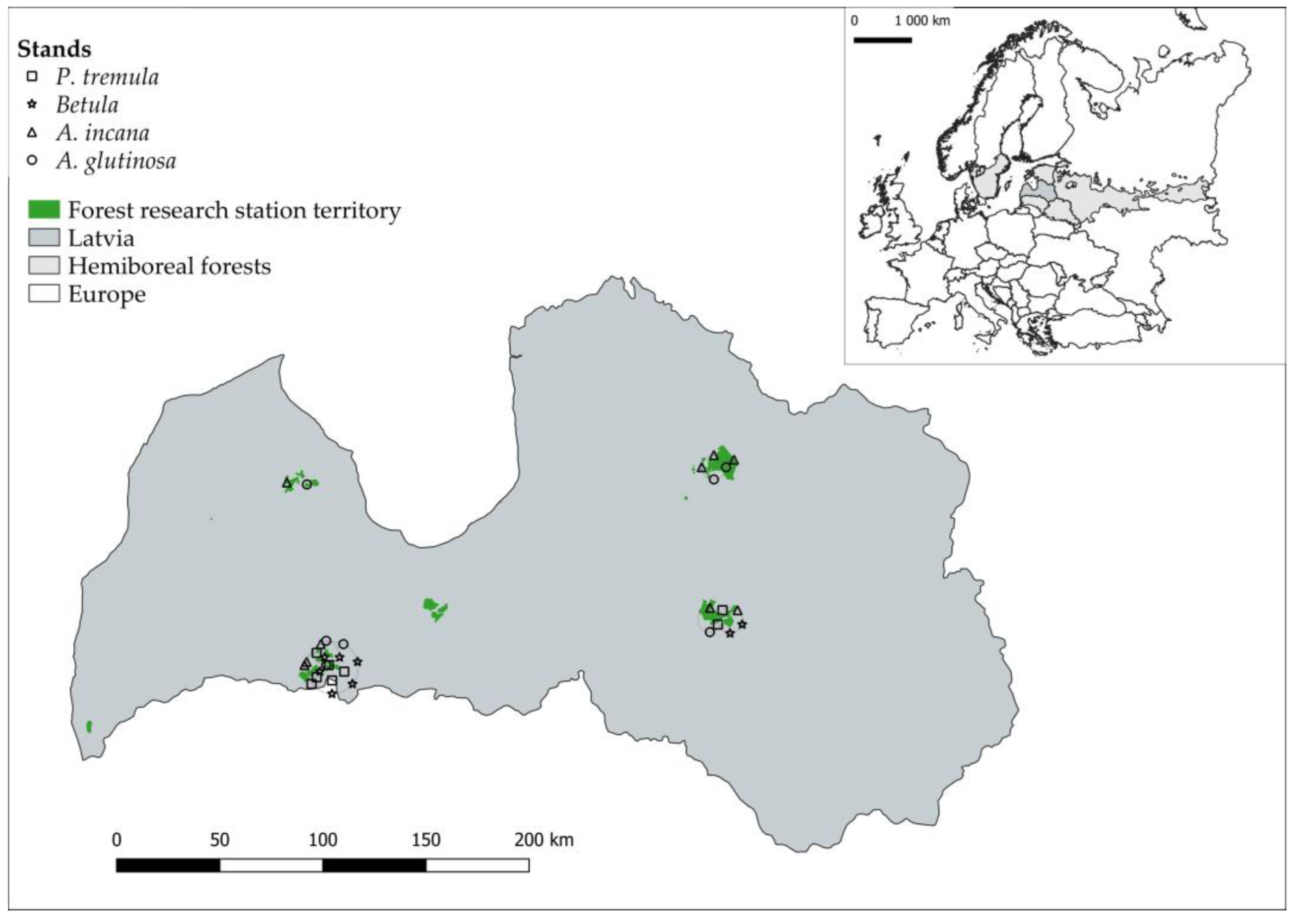
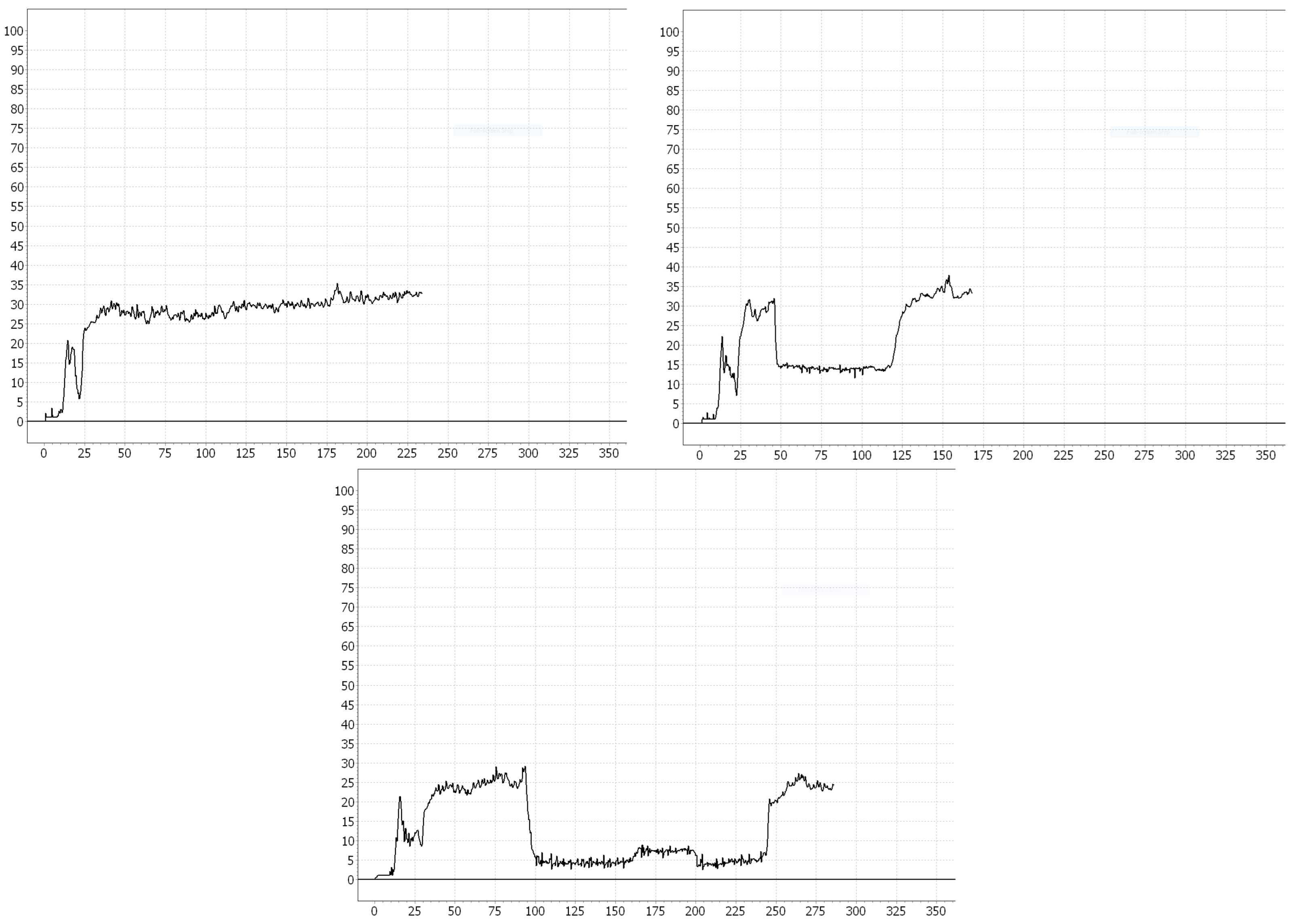
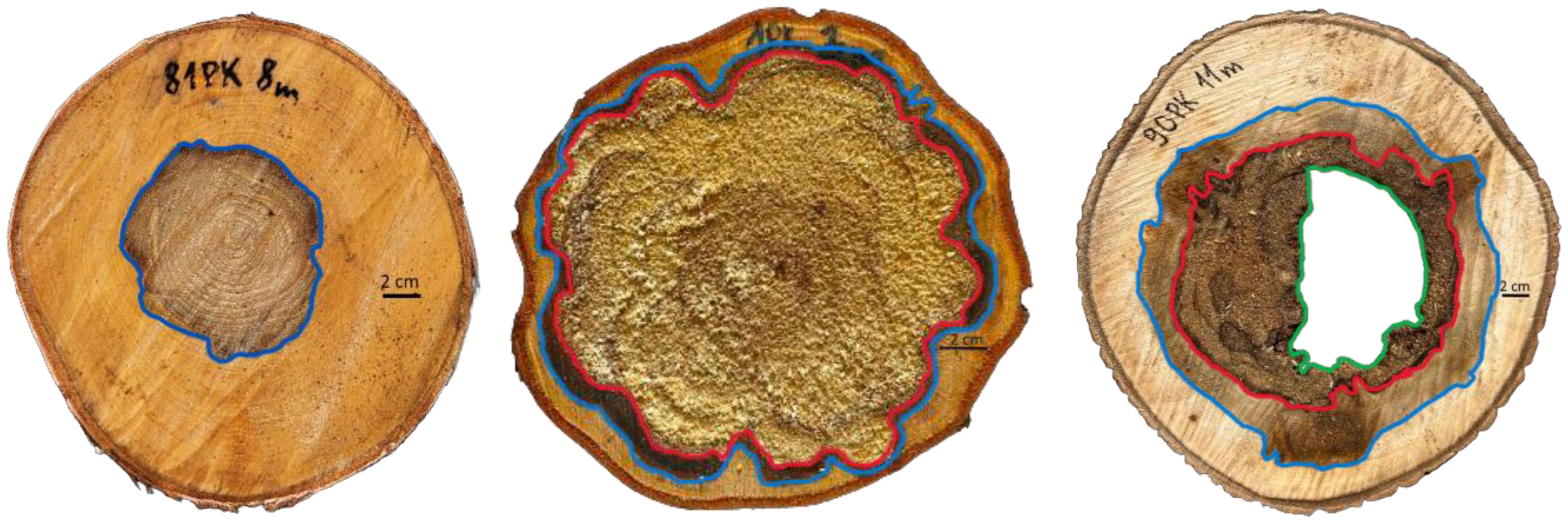
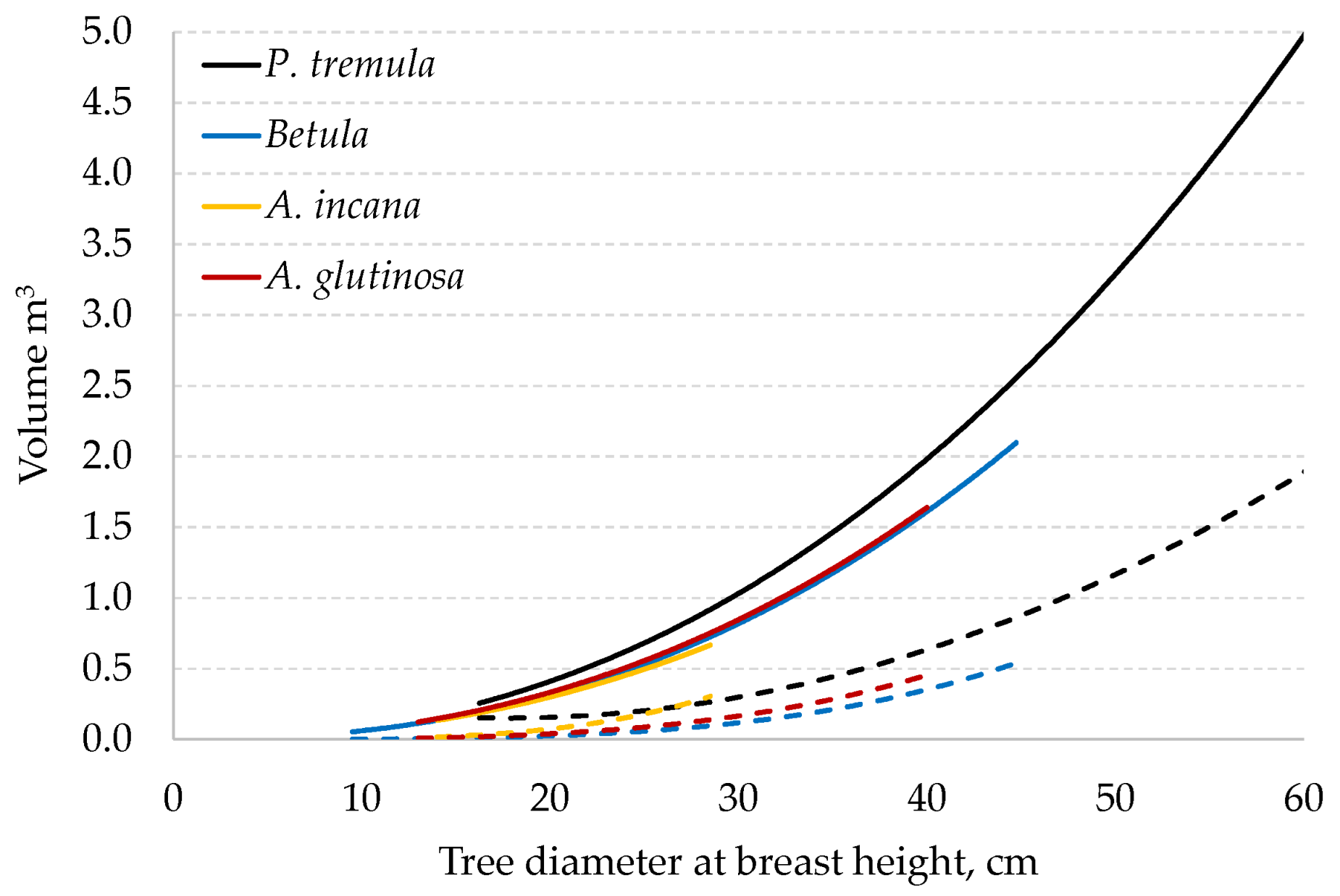
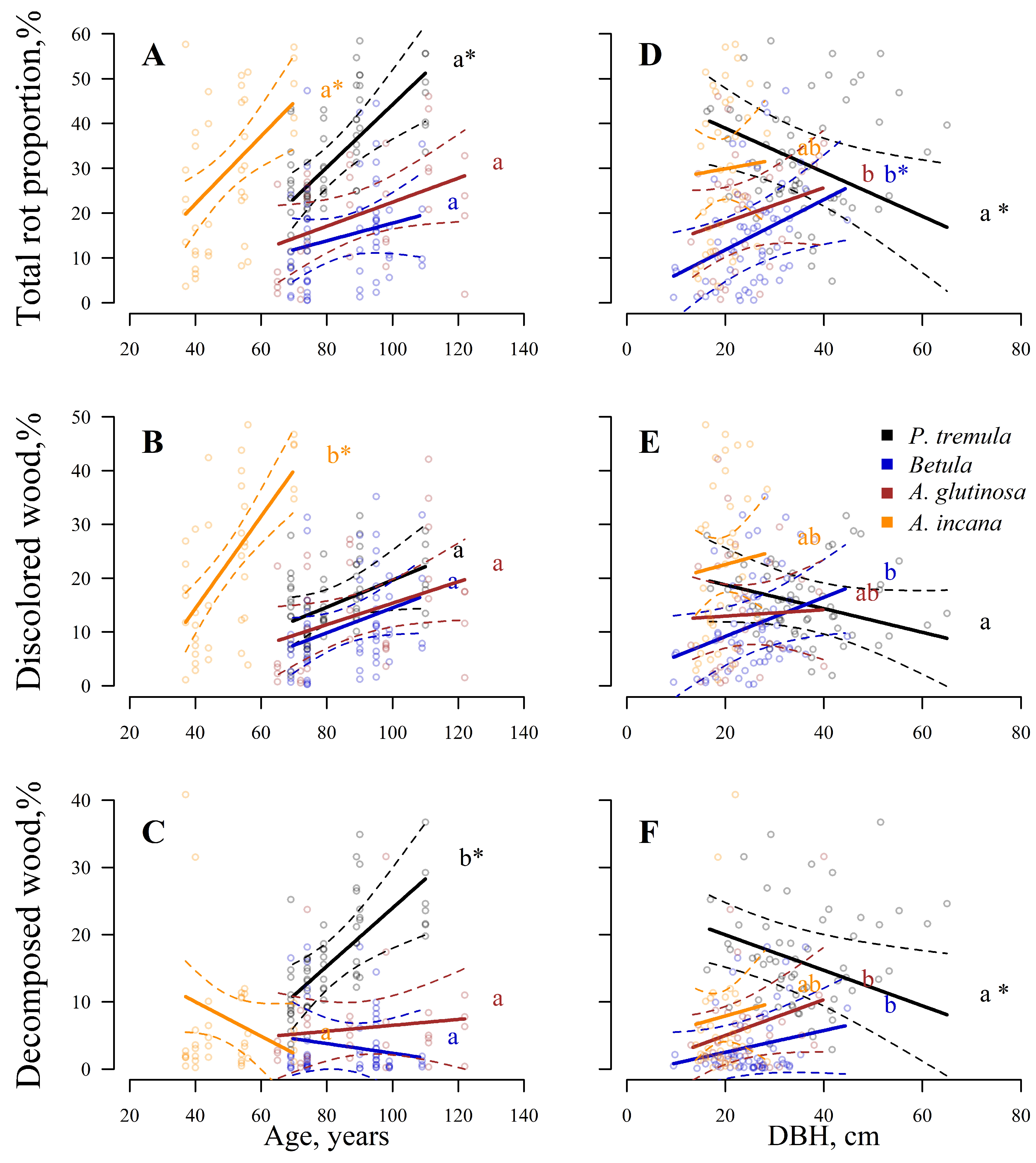
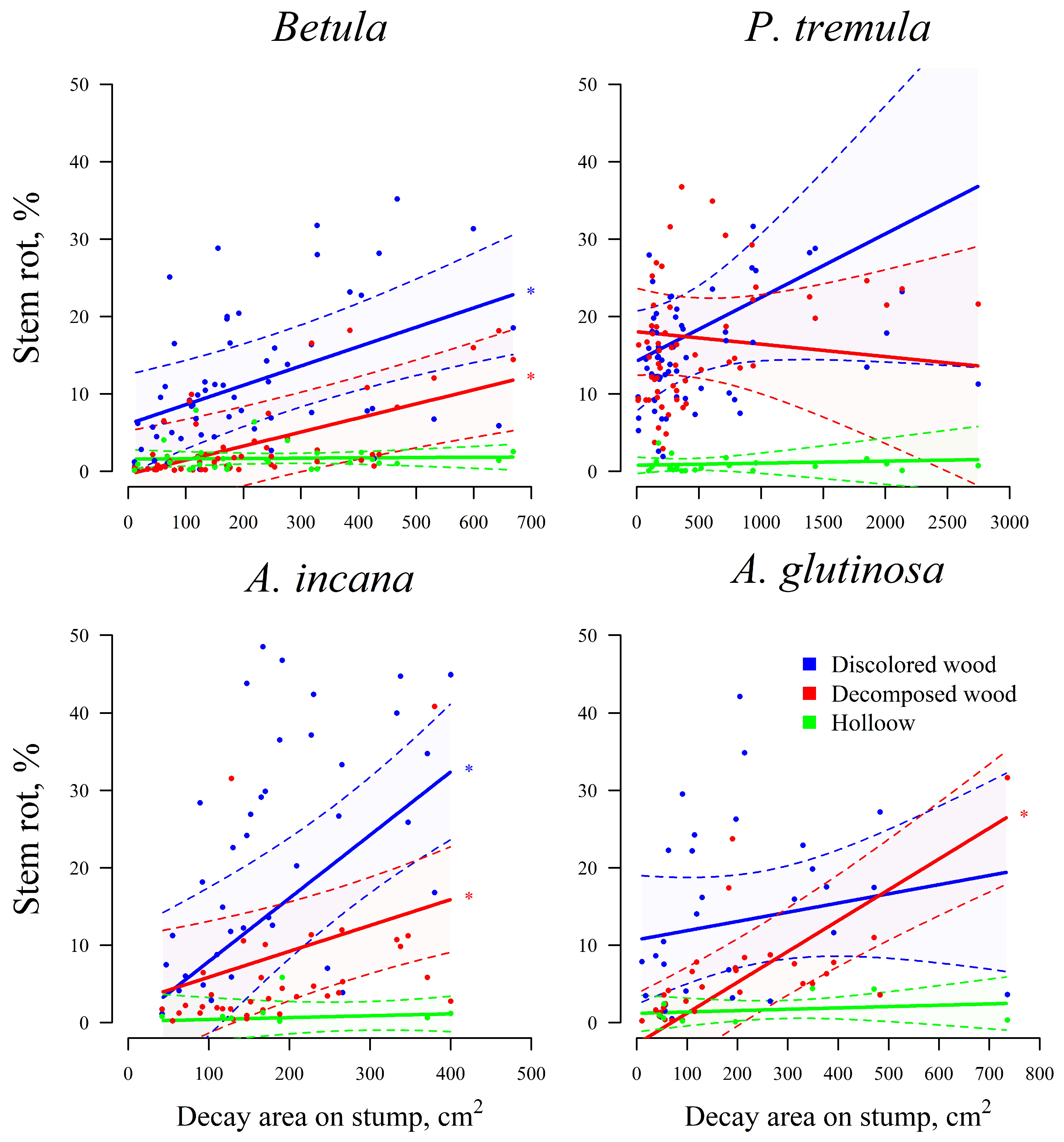

| Dominant Species | Number of Stands | Age, Years | Diameter at Breast Height, cm | Tree Height, m | Number of Dominant Trees, ha−1 | Proportion of Decayed Trees, % |
|---|---|---|---|---|---|---|
| Betula | 8 | 85.5 (69–109) | 25.5 (20.9–29.9) | 24.0 (19.9–28.4) | 455 (340–620) | 31.6 (11.8–100) |
| P. tremula | 8 | 81.8 (69–110) | 39.2 (30.1–55.2) | 32.8 (27.8–38.1) | 230 (140–320) | 61.2 (10.0–100) |
| A. glutinosa | 7 | 89.8 (65–122) | 27.8 (20.6–32.6) | 24.8 (22.7–26.7) | 600 (240–900) | 38.6 (6.7–93.3) |
| A. incana | 9 | 48.1 (37–70) | 21.0 (17.0–31.0) | 21.5 (18.1–24.4) | 860 (420–1260) | 27.7 (2.4–81.0) |
| Parameters | Betula (N = 60) | P. tremula (N = 60) | A. incana (N = 38) | A. glutinosa (N = 32) | ||||
|---|---|---|---|---|---|---|---|---|
| Mean ± SD | Range | Mean ± SD | Range | Mean ± SD | Range | Mean ± SD | Range | |
| Tree H, m | 23.9 ± 3.9 | 13.1–31.8 | 32.0 ± 3.7 | 18.7–39.3 | 20.8 ± 2.4 | 16.3–26 | 23.3 ± 3.1 | 11.9–28.5 |
| Tree DBH, cm | 25.1 ± 6.5 | 9.5–44.7 | 35.8 ± 10.3 | 16.25–65.0 | 19.3 ± 3.5 | 14.0–28.5 | 23.9 ± 6.7 | 13.0–40.0 |
| Stem volume, m−3 | 0.6 ± 0.3 | 0.1–2.1 | 1.7 ± 1.1 | 0.2–5.7 | 0.3 ± 0.1 | 0.1–0.7 | 0.6 ± 0.4 | 0.1–1.7 |
| Total length of decay, m | 9.9 ± 5.7 | 1.1–23.6 | 19.3 ± 5.5 | 5.2–27.9 | 10.7 ± 4.5 | 2.2–18.2 | 11.5 ± 4.8 | 1.4–18.8 |
| Length of decomposed wood column, m | 2.5 ± 2.8 | 0.2–13.9 | 15.0 ± 6.5 | 3.5–27.2 | 1.1 ± 1.1 | 0.3–5.5 | 2.7 ± 3.3 | 0.4–13.2 |
| Lenght of hollow column, m | 1.1 ± 1.0 | 0.2–3.9 | 1.4 ± 1.4 | 0.1–6.5 | 0.7 ± 0.2 | 0.5–1.2 | 1.3 ± 0.9 | 0.4–2.8 |
| Total diameter of decay at stump level, cm | 13.8 ± 6.3 | 2.7–29.7 | 20.9 ± 11.5 | 4.25–58 | 14.2 ± 4.0 | 8.0–19.5 | 13.9 ± 6.1 | 4.8–25.5 |
| Diameter of decomposed wood at stump level, cm | 11.5 ± 5.7 (N = 49) | 1.2–27.5 | 14.3 ± 8.0 (N = 51) | 1.25–39.7 | 13.1 ± 4.8 (N = 34) | 3.5–23.5 | 13.3 ± 6.1 (N = 28) | 3.8–29.0 |
| Diameter of hollow at stump level, cm | 11.4 ± 4.8 (N = 27) | 3.7–21.0 | 12.1 ± 7.7 (N = 11) | 1–30.5 | 8.7 ± 2.9 (N = 7) | 5.3–14.5 | 10.3 ± 6.2 (N = 8) | 3.8–23.8 |
| Total decay proportion (% of volume) | 15.5 ± 11.4 | 0.5–47.3 | 31.9 ± 12.6 | 4.8–58.5 | 28.5 ± 16.7 | 3.7–57.6 | 20.1 ± 12.3 | 0.8–46.1 |
| Decomposed wood proportion (% of volume) | 3.6 ± 4.9 (N = 58) | 0.01–18.2 | 16.3 ± 7.6 (N = 60) | 2.91–36.7 | 6.4 ± 8.3 (N = 36) | 0.2–40.8 | 6.3 ± 6.8 (N = 31) | 0.2–31.6 |
| Hollow proportion (% of volume) | 1.7 ± 1.8 (N = 30) | 0.1–7.9 | 0.8 ± 0.8 (N = 24) | 0.01–3.6 | 1.5 ± 1.8 (N = 7) | 0.2–5.8 | 1.7 ± 1.7 (N = 8) | 0.1–4.4 |
| Fixed Effects | Response Variables | |||
|---|---|---|---|---|
| Total Rot | Discolored Wood | Decomposed Wood | Hollow | |
| Species | 50.5 *** | 44.3 *** | 41.2 *** | 0.8 |
| Age | 16.7 *** | 20.2 *** | 1 | 0.7 |
| DBH | 0.5 | 2.5 | 0.1 | 0.1 |
| H | 0.1 | 2.4 | 3.4 | 0.5 |
| Species: Age | 13.2 ** | 13.0 ** | 23.9 *** | 0.3 |
| Species: DBH | 8.9 * | 5.3 | 7.5 * | 0.3 |
| Species: H | 2.3 | 3.4 | 1.8 | 0.9 |
| Conditional R2 | 0.57 | 0.49 | 0.75 | 0.25 |
| Marginal R2 | 0.46 | 0.37 | 0.50 | 0.18 |
| Fixed Effects | Response Variables | ||
|---|---|---|---|
| Discolored Wood | Decomposed Wood | Hollow | |
| Species | 9.1 * | 26.6 *** | 3.4 |
| Stump diameter | 1.5 | 3.9 * | 1.0 |
| Stump rot area | 19.4 *** | 17.2 *** | 0.3 |
| Species: Stump diameter | 9.1 * | 4.7 | 0.5 |
| Species: Rot area on stump | 17.5 *** | 40.1 *** | 0.3 |
| Conditional R2 | 0.58 | 0.83 | 0.17 |
| Marginal R2 | 0.22 | 0.35 | 0.10 |
Disclaimer/Publisher’s Note: The statements, opinions and data contained in all publications are solely those of the individual author(s) and contributor(s) and not of MDPI and/or the editor(s). MDPI and/or the editor(s) disclaim responsibility for any injury to people or property resulting from any ideas, methods, instructions or products referred to in the content. |
© 2023 by the authors. Licensee MDPI, Basel, Switzerland. This article is an open access article distributed under the terms and conditions of the Creative Commons Attribution (CC BY) license (https://creativecommons.org/licenses/by/4.0/).
Share and Cite
Liepiņš, J.; Liepiņš, K.; Lazdiņš, A.; Matisons, R.; Jansons, Ā. A Comparative Study of Stem Rot Severity in Mature Deciduous Trees in Latvia. Sustainability 2024, 16, 144. https://doi.org/10.3390/su16010144
Liepiņš J, Liepiņš K, Lazdiņš A, Matisons R, Jansons Ā. A Comparative Study of Stem Rot Severity in Mature Deciduous Trees in Latvia. Sustainability. 2024; 16(1):144. https://doi.org/10.3390/su16010144
Chicago/Turabian StyleLiepiņš, Jānis, Kaspars Liepiņš, Andis Lazdiņš, Roberts Matisons, and Āris Jansons. 2024. "A Comparative Study of Stem Rot Severity in Mature Deciduous Trees in Latvia" Sustainability 16, no. 1: 144. https://doi.org/10.3390/su16010144
APA StyleLiepiņš, J., Liepiņš, K., Lazdiņš, A., Matisons, R., & Jansons, Ā. (2024). A Comparative Study of Stem Rot Severity in Mature Deciduous Trees in Latvia. Sustainability, 16(1), 144. https://doi.org/10.3390/su16010144







